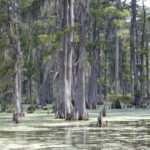I’ve just finished with a trip into the woods of southern Illinois. It wasn’t anything particularly dangerous: head to a cypress swamp, hike deep into the woods, visit a natural lake. Now, there’s not much here that can really endanger someone. The scenery’s pretty idyllic, with rolling hills and steep mountains which seem a little unfamiliar for Illinois. I’m a big fan of collecting insects and arachnids in tiny jars of ether, so I wasn’t surprised when I found a rather intimidating collection of pretty terrifying spiders crawling all over the land. While most people think that dangerous spiders are a thing of the outback, or some obscure flats on the American Southwest, there are a lot of them found much closer than you’d think. In this article, I’ll cover three of the more dangerous species of spiders which can be found in the states.
Easily the most dangerous American spider is the black widow. Most everyone’s heard of it and its reputation for a dangerous bite. However, most people don’t know where it’s found. The spider’s rather famous for its looks: it has a jet black body with a red hourglass on its abdomen. Like other spiders, its carapace has a very velvety quality. The adult female, the most dangerous of the breed, is about an inch and a half long when mature. The adult male, on the other hand, is much smaller. It has a similar black color but is striped white and yellow in addition to its red hourglass coloration. Surprisingly, the spider is most commonly found under and within piles of dry lumber which has been sitting for some time. For example, while pulling logs away from a fire ring, I happened upon no fewer than six black widow spiders. Spooky. The web of the spider is fairly unremarkable in that it does not display any of the fine structure or symmetry of most spider webs, instead being fairly “poorly” constructed, resembling sheets of silk rather than webs. When bit by one of these spiders, you may feel very little immediate pain or discomfort. The bite area may swell a little bit originally, but is rather indistinguishable from a mosquito bite. However, after time, muscle spasms and rigidity can occur, followed by difficulty while breathing and feelings of nausea. The spider’s fairly easy to stay away from if you follow the basic rule of looking before you reach.
It’s a little hard to do a lot of work out in the wilderness if you’re legitimately scared of something which is out there. An old classmate of mine refuses to go out at all due to a fear of ticks. If I had to pick a specie that I was simply terrified by, though, it would have to be the brown recluse spider. This spider’s particularly dangerous to campers and other outdoorsy-type folks mainly because it simply loves to crawl into dark, dry places and simply sit until disturbed. This includes cars, sleeping bags, luggage bags, and most everything else you’d leave lying around on a camping trip. The spider is a light to dark brown color with a pattern like a fiddle on its back. It’s a fairly small spider, less than an inch and a half long, and can resemble the much more innocuous daddy long legs spider. The bite from the spider is very rarely fatal, but its aftereffects can be quite dangerous. Sometimes the spider bites go completely unnoticed without any sorts of effects. However, if toxin has been injected into the body, the site of the bite can often accumulate necrotized tissue leaving a wound rather akin to a bullet hole which is very aesthetically unappealing.
Tarantulas are the classic horror movie spider. They’re big, hairy, and very intimidating in comparison to something like the brown recluse. They can reach a size of six inches in length, a size which is regularly stocked in pet shops. The tarantula frequents rocky areas, but it’s rather uncommon in the states due to its relatively large size. Like the brown recluse and the black widow, the spiders aren’t particularly aggressive. On most occasions of contact, the spider will attempt to flee instead of trying to bite. If a bite does occur, it shouldn’t really be considered as such a big deal. The venom isn’t very toxic and does not cause many lasting effects. The real danger which these spiders carry rests in their myriad body hairs. The majority of the hairs are very irritating to skin and can cause allergic reactions in many people. If a spider is threatened, it may raise itself on its rear legs and fire hairs from its abdomen. These hairs contain a very toxic substance which can cause a lot of skin irritation, a much more intense version of the usual reaction.
That’s about the rundown. However, although this article paints a pretty terrifying picture of spiders, these are fairly specific cases. All of these spiders aren’t aggressive and would much rather be left alone than be disturbed. They will only bite when well provoked and baited. Most spiders, on the other hand, aren’t at all venomous and are even more reclusive than these larger spiders. All in all, the best course of action for spiders is to admire them from afar and never provoke.





